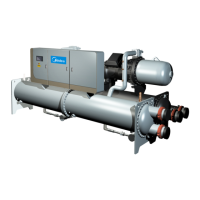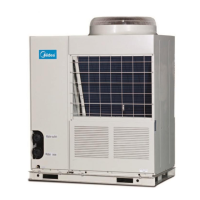Aqua Tempo Super II
74 201709
Midea Aqua Tempo Super II
Service Manual
control box can be used to determine whether the xL8/xL9 error is being caused by a compressor fault or a main PCB
fault:
If using another unit in the same system as the unit with the error to perform the test, set it as the master unit
(address 0); if using a unit in another system, use the master unit.
Disconnect the power wires of the compressor referenced in the xL8/xL9 error code.
In the unit that is operating normally, disconnect the power wires that connect a compressor to the electric
control box and use them to connect the compressor with the xL8/xL9 error to the electric control box of the
unit that is operating normally. Ensure that the U, V, W terminals are connected in the right order, and then start
the system that is operating normally.
If the compressor with the xL8/xL9 error runs normally, replace the main PCB of the unit with the xL8/xL9 error
and ensure the wiring is correct; if the compressor with the xL8/xL9 error still does not run normally, it needs to
be replaced. Refer to Part 4, 4.12.10 “Compressor replacement procedure”.
Figure 4-4.11: Connecting compressor to an error-free unit
If there is no error-free unit nearby:
Replace the main PCB of the unit with the xL8/xL9 error and ensure the wiring is correct. If the compressor with
the xL8/xL9 error runs normally, a fault with the main PCB was causing the xL8/xL9 error; if the compressor with
the xL8/xL9 error still does not run normally, it needs to be replaced. Refer to Part 4, 4.12.10 “Compressor
replacement procedure”.
Compressor replacement procedure 4.12.10
Step 1: Remove faulty compressor and remove oil
Remove the faulty compressor from the outdoor unit.
Before removing the oil, shake the compressor so as to not allow
impurities to remain settled at the bottom.
Drain the oil out of the compressor and retain it for inspection.
Normally the oil can be drained out from the compressor discharge
pipe. Refer to Figure 4-4.12.
Step 2: Inspect oil from faulty compressor
The oil should be clear and transparent. Slightly yellow oil is not an indication of any problems. However, if the oil is
dark, black or contains impurities, the system has problems and the oil needs to be changed. Refer to Figure 5-4.16
for further details regarding inspecting compressor oil. (If the compressor oil has been spoiled, the compressor will
not be being lubricated effectively. The scroll plate, crankshaft and bearings will wear. Abrasion will lead to a larger
load and higher current. More electric energy will get dissipated as heat and the temperature of the motor will
become increasingly high. Finally, compressor damage or burnout will result. Refer to Figure 4-4.13.)
Step 3: Check oil in other compressors in the system
Figure 4-4.12: Draining oil from a compressor
Power line (U, V, W terminals)

